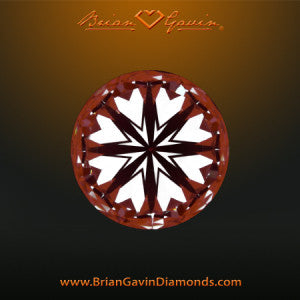The Science behind Brian Gavin Signature diamonds
Just as there is a science to cutting a diamond that offers the highest volume of light return and sparkle factor, there is a science to grading diamonds. If you ever had the opportunity to poke your head into the grading room of the Gemological Institute of America Gem Trade Laboratory (GIA) or the American Gem Society Laboratory (AGSL) you would see rows upon rows of microscopes, and specialized equipment that makes it possible to grade diamonds with the highest degree of accuracy and consistency, everything looks very scientific. However only the AGS Laboratory offers Angular Spectrum Evaluation Technology (ASET) and it is a game changer.
What is it about a diamond that makes it special?
Have you ever stopped to wonder what it is about a diamond that makes it so special? It certainly isn’t how incredible and sparkly they look when they come out of the ground, because the fact of the matter is that they look like a dull, lifeless rock.
 It takes incredible skill, a great deal of planning, and even a bit of vision, to produce diamonds that are truly stunning. The hearts and arrows patterns exhibited by Brian Gavin Signature round diamonds is not the direct result of the basic facet structure of a round brilliant cut diamond, nor even the ideal proportions, it can only be created if every facet polished upon the surface of the diamond is perfectly shaped and aligned with every other facet on the diamond. To this regard, every facet on the diamond has a purpose, and must work in harmony with all the other facets. If even a single facet is off even the slightest little bit, the hearts pattern will be distorted.
It takes incredible skill, a great deal of planning, and even a bit of vision, to produce diamonds that are truly stunning. The hearts and arrows patterns exhibited by Brian Gavin Signature round diamonds is not the direct result of the basic facet structure of a round brilliant cut diamond, nor even the ideal proportions, it can only be created if every facet polished upon the surface of the diamond is perfectly shaped and aligned with every other facet on the diamond. To this regard, every facet on the diamond has a purpose, and must work in harmony with all the other facets. If even a single facet is off even the slightest little bit, the hearts pattern will be distorted.
 Brian Gavin loves the craft of diamond cutting, and that is why his diamonds are so spectacular, so breathtaking to look at. He approaches diamond cutting as if it were a science, because quite frankly, it is. And he knows without a doubt, that every diamond produced is going to be a masterpiece if he follows a simple formula, which has been handed down and perfected for the past five generations. Brian Gavin insists on sending Brian Gavin Signature diamonds to the AGSL to be graded, because their proprietary ASET scan provides his clients with the scientific proof that they need to know that his diamonds are the very best! One look at the picture and you can see the consistency of light return.
Brian Gavin loves the craft of diamond cutting, and that is why his diamonds are so spectacular, so breathtaking to look at. He approaches diamond cutting as if it were a science, because quite frankly, it is. And he knows without a doubt, that every diamond produced is going to be a masterpiece if he follows a simple formula, which has been handed down and perfected for the past five generations. Brian Gavin insists on sending Brian Gavin Signature diamonds to the AGSL to be graded, because their proprietary ASET scan provides his clients with the scientific proof that they need to know that his diamonds are the very best! One look at the picture and you can see the consistency of light return.
And while the presence of a crisp and complete pattern of hearts and arrows has nothing to do with ASET, or how fantastic Brian Gavin Signature diamonds look through an ASET Scope, one look at the ASET Scope image, and you know that the diamond is going to be incredibly bright, that it is picking up light from all over the room, and reflecting it back in all the right places. One look at the picture and you know that the diamond exhibits exceptional contrast brilliance. That is if you know how to interpret the different colors of an ASET Scope, well, that’s easy enough to understand.
The color red represents the brightest light available to the diamond in the room, the light which strikes off the surface of the diamond from perpendicular to the table facet up to forty-five degrees.
The color green represents the second brightest light available to the diamond in the room, the light which strikes off the surface of the diamond from forty-five degrees, out to the edge of the horizon.
And the color blue represents the contrast exhibited by the diamond, this is created when light which could be entering the diamond, is blocked by our heads, or in this case the camera lens.
No other gemological laboratory offers the scientific approach to diamond grading that is provided by the American Gem Society Laboratory, and that is why Brian Gavin Signature diamonds are submitted to the AGSL for grading. To learn more about the grading standards of the American Gem Society Laboratory, and the Light Performance Cut Grade, read this article.
Photo credit, The Scientific Difference: AGS Laboratory




















